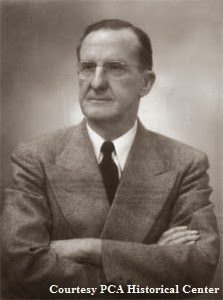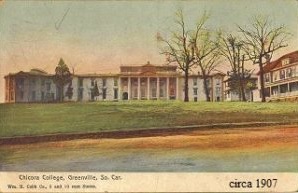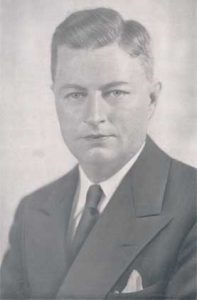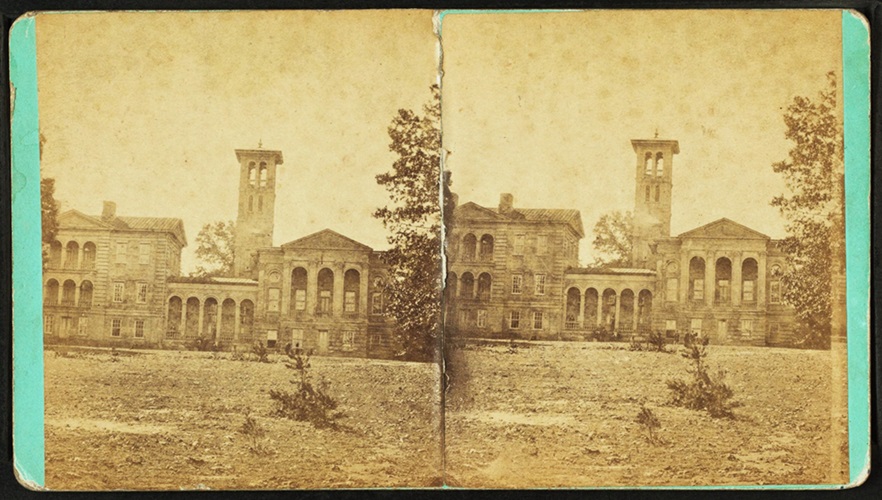 Flournoy was born to Joel Alexander and Lucetta Cheatham Shepperson in Columbus, Arkansas, January 10, 1883. His education included a Bachelor of Arts from Arkansas College, then he completed his ministerial studies in Union Theological Seminary in Virginia. At the time, the seminary included in its faculty, G. B. Strickler, T. C. Johnson, W. W. Moore, T. R. English, and others. Shepperson was also student associate editor of the seminary’s journal, Union Seminary Magazine.
Flournoy was born to Joel Alexander and Lucetta Cheatham Shepperson in Columbus, Arkansas, January 10, 1883. His education included a Bachelor of Arts from Arkansas College, then he completed his ministerial studies in Union Theological Seminary in Virginia. At the time, the seminary included in its faculty, G. B. Strickler, T. C. Johnson, W. W. Moore, T. R. English, and others. Shepperson was also student associate editor of the seminary’s journal, Union Seminary Magazine.
Having been prepared theologically for the ministry, young Shepperson sought experience and a pastoral call. He was licensed October 10, 1908, then ordained the following day. Even though the intention of licensure is to provide a ministerial candidate with an extended opportunity to test and practice his gifts, it was not uncommon for candidates to be licensed, then ordained in short order despite the requirements of the form of government or book of church order. His first ministry was a dual call to churches in Magnolia and Mt. Holly, Arkansas. Following the yoked call, he moved east in 1911 to Monticello for a nine-year ministry. It must have been during one of his first calls that he met Nellie McGill of Camden, Arkansas. The two were married in 1912.
The Sheppersons left Arkansas headed east to South Carolina where Flournoy had been offered a call on November 7, 1920, to serve the Purity Church in Chester. According to the Minutes of the Synod of South Carolina, 1921, Purity Church had 550 communicant members and was the third largest church in Bethel Presbytery behind First Church, Rock Hill, and First Church, York. The Sheppersons left Purity in 1925 after a short but fruitful ministry. His next call was to Second Presbyterian Church, Greenville.
 When the Sheppersons arrived in Greenville in January 1926, Flournoy was entering what could have been a challenging situation. Dr. E. P. Davis had retired after a ministry of just over twenty years. Davis had raised his family in the old manse, his daughters attended Chicora College which was located just across the street from the church property. He had baptized and then united in marriage many in the congregation, and he was a respected elder in Enoree Presbytery who became stated clerk once retired from his pastoral call. It is not always easy for a new minister to follow one that served a congregation for a full generation, especially one whose presence was still felt due to his continued residence in Greenville. It seems that Shepperson managed the challenges well because when he left the church in 1940, after a ministry of fourteen years, he was on his way to surpassing the tenure of his predecessor.
When the Sheppersons arrived in Greenville in January 1926, Flournoy was entering what could have been a challenging situation. Dr. E. P. Davis had retired after a ministry of just over twenty years. Davis had raised his family in the old manse, his daughters attended Chicora College which was located just across the street from the church property. He had baptized and then united in marriage many in the congregation, and he was a respected elder in Enoree Presbytery who became stated clerk once retired from his pastoral call. It is not always easy for a new minister to follow one that served a congregation for a full generation, especially one whose presence was still felt due to his continued residence in Greenville. It seems that Shepperson managed the challenges well because when he left the church in 1940, after a ministry of fourteen years, he was on his way to surpassing the tenure of his predecessor.
However, there was a problem Shepperson faced during his Greenville years that went well beyond the Second Church property at the corner of River and Rhett. The years of the nineteen twenties, then into the thirties constituted a difficult and divisive era in American Presbyterianism. In the 1880s, Presbyterians had seen controversies involving C. A. Briggs, who taught in Union Seminary, New York, and James Woodrow, who taught in Columbia Theological Seminary in South Carolina. Dr. Briggs had been influenced by German higher critical scholarship with respect to the text of the Bible, inerrancy, the authorship of some of the books of the Bible, and issues related to the Pentateuch. In the case of Woodrow, some opposed his continued teaching in the seminary because his teaching showed that he had been influenced by the theory of evolution. Even though the issues involving Briggs and the Bible in New York, and Woodrow and evolution in Columbia seem unrelated, both cases represented an increased confidence in the findings of academia for calling into question the teachings of Scripture. Where biblical interpreters of the past had sought to resolve what appeared to be contradictions in the Bible, there was an increasing number too ready to throw up their hands in exasperation and proclaim any textual or exegetical dilemma an error. The ministers and teachers schooled by Briggs and Woodrow would influence their congregants and students well into the twentieth century in both the Presbyterian Church in the United States of America (PCUSA) and the Presbyterian Church in the United States (PCUS).
In the case of Flournoy Shepperson, he was concerned that Darwin’s theory of evolution was being taught in PCUS educational institutions, and he believed that those using higher critical methodology for biblical studies in the denominational schools needed to be exposed to the members of the PCUS for removal from faculties. As the controversy progressed, it became clear to Shepperson that the resolution to the educational problems could only be resolved through interdenominational schools such as Columbia Bible College. He also believed that orthodox beliefs necessarily included pre-millennial eschatology, resulting in  Shepperson’s emphases leading to disharmony in Second Church because some sided with him but others wanted to continue to support the denomination and its institutions. The situation was resolved when the majority of the congregation left with Shepperson to establish the Bible Presbyterian Church (BPC) of Greenville, while Second Church retained the property and continued in its original denomination. The BPC had been established by Rev. Carl McIntire in response to modernism in the PCUSA. McIntire completed his divinity degree at Westminster Theological Seminary, which had recently been founded by J. Gresham Machen and other faculty that left Princeton Seminary. McIntire was ordained in the PCUSA, but then divested in 1935, which led him to join with others to establish the BPC.
Shepperson’s emphases leading to disharmony in Second Church because some sided with him but others wanted to continue to support the denomination and its institutions. The situation was resolved when the majority of the congregation left with Shepperson to establish the Bible Presbyterian Church (BPC) of Greenville, while Second Church retained the property and continued in its original denomination. The BPC had been established by Rev. Carl McIntire in response to modernism in the PCUSA. McIntire completed his divinity degree at Westminster Theological Seminary, which had recently been founded by J. Gresham Machen and other faculty that left Princeton Seminary. McIntire was ordained in the PCUSA, but then divested in 1935, which led him to join with others to establish the BPC.
The BPC served by Dr. Shepperson became the Augusta Street Presbyterian Church which later became a congregation of the Reformed Presbyterian Church, Evangelical Synod (RPCES). In 1969, Mitchell Road Presbyterian Church (RPCES) was seeded with congregants from the Augusta Street Church membership. Both Augusta Street and Mitchell Road continued their ministries in the RPCES until they united with the Presbyterian Church in America (PCA) in 1982. The Augusta Street Church did not fare as well and as the years passed it declined in membership and ministry sufficiently for Calvary Presbytery to dissolve the congregation in 1996, but Mitchell Road Church continues its ministry today and operates a Christian school. Thus, the division of Second Church, Greenville during Shepperson’s ministry that resulted in establishment of Augusta Road Church, then seeded Mitchell Road Church, led to a denominational reunion of the two congregations from Second in a connectional relationship in Calvary Presbytery, PCA.
Dr. Shepperson continued serving the Augusta Street Church and became a well-respected minister in the BPC and then the RPCES. In 1957, the Augusta Street congregation honored him by celebrating his life and many years of pastoral care with a special service and time of remembrance. Dr. Shepperson survived until January 15, 1966, when he died and was buried next to Nellie in Greenville. The Sheppersons had a daughter and three sons. He had been honored with the Doctor of Divinity by Arkansas College in 1919, and he moderated the Bible Presbyterian Church Synod (highest judicatory in the denomination) meeting held at Harvey Cedars, New Jersey, in 1945. The Seventeenth General Synod of the BPC was held in Rev. Shepperson’s church in Greenville in June 1954. Stated Clerk Robert “Scotty” Hastings was serving at his desk while the gavel was managed by Moderator Linwood G. Gebb, minister of the church in Lakewood, Florida.
Barry Waugh
Notes–The header is a stereo view of the Greenville, South Carolina campus of Furman University after the campus was moved there from Edgefield in 1851 and before its move to the current location in the late 1950s; the image titled, “Old Main, Furman University, Greenville, South Carolina,” is from the New York Public Library Digital Collection of The Miriam and Ira D. Wallach Division of Art, Prints and Photographs. If readers are confused by the myriad mixtures of the letters “C,” “P,” “A,” “S,” “U,” etc., in the abbreviations of Presbyterian denominations they should understand that they are not alone, but relief is to be found with the chart inside the front cover of Seeking a Better Country, 300 Years of American Presbyterianism, P&R, 2007, by D. G. Hart and John Muether, which explains via flow chart the confusing catalog of similarly named denominations. The portrait of Rev. Shepperson (glasses and arms crossed), and picture of Carl McIntire (handkerchief in his pocket) were provided by the PCA Historical Center, Wayne Sparkman, Director.





